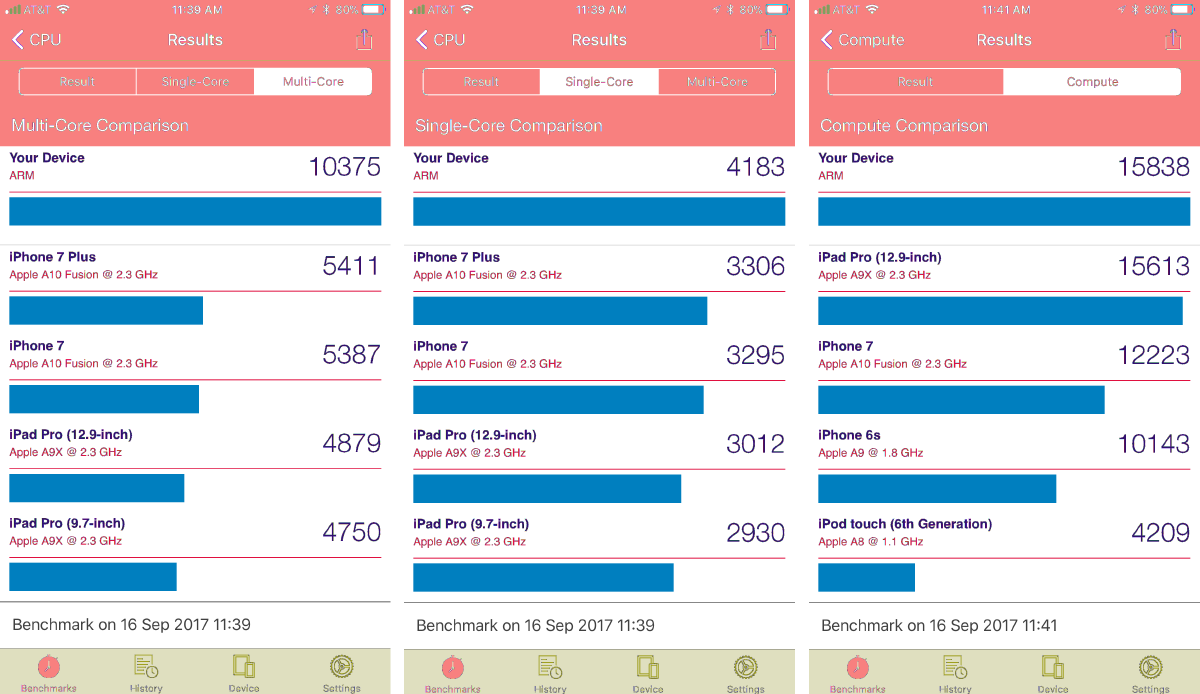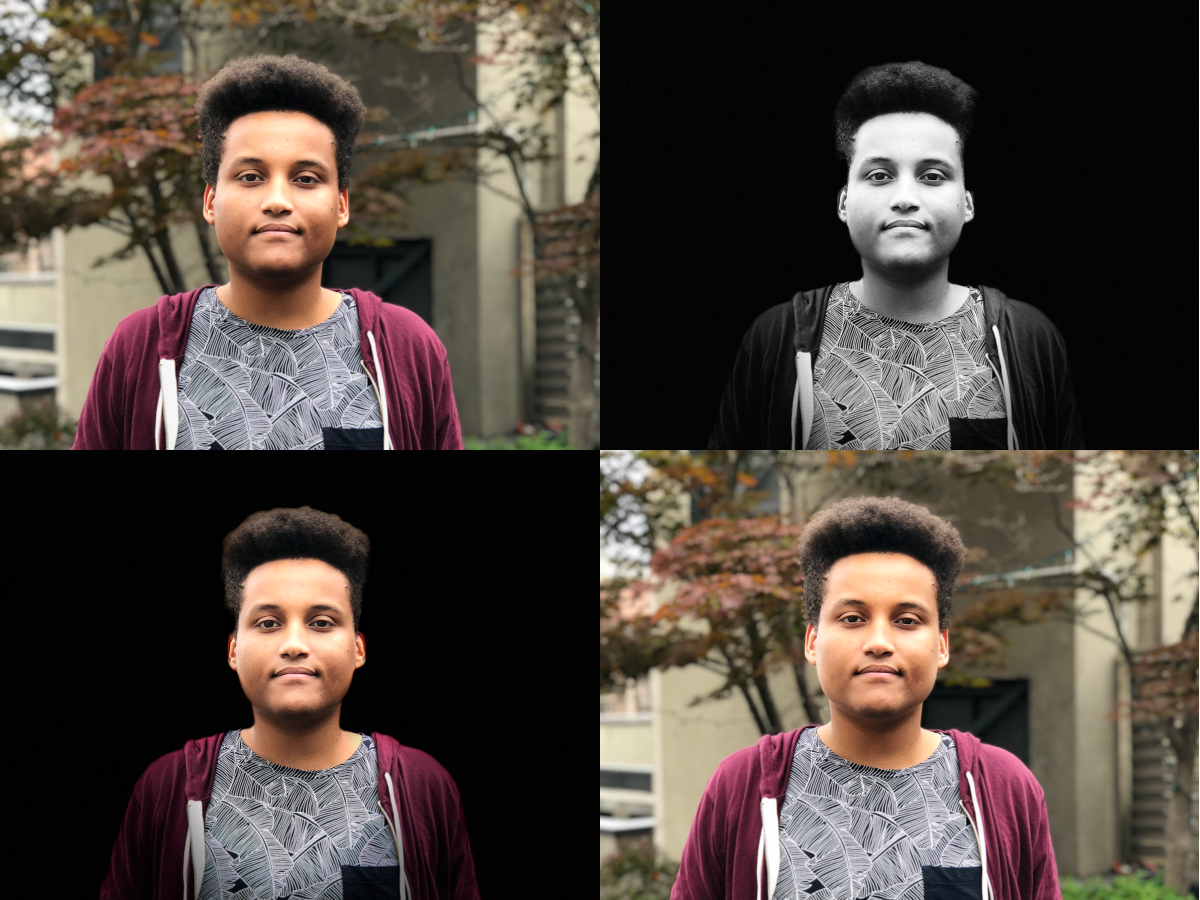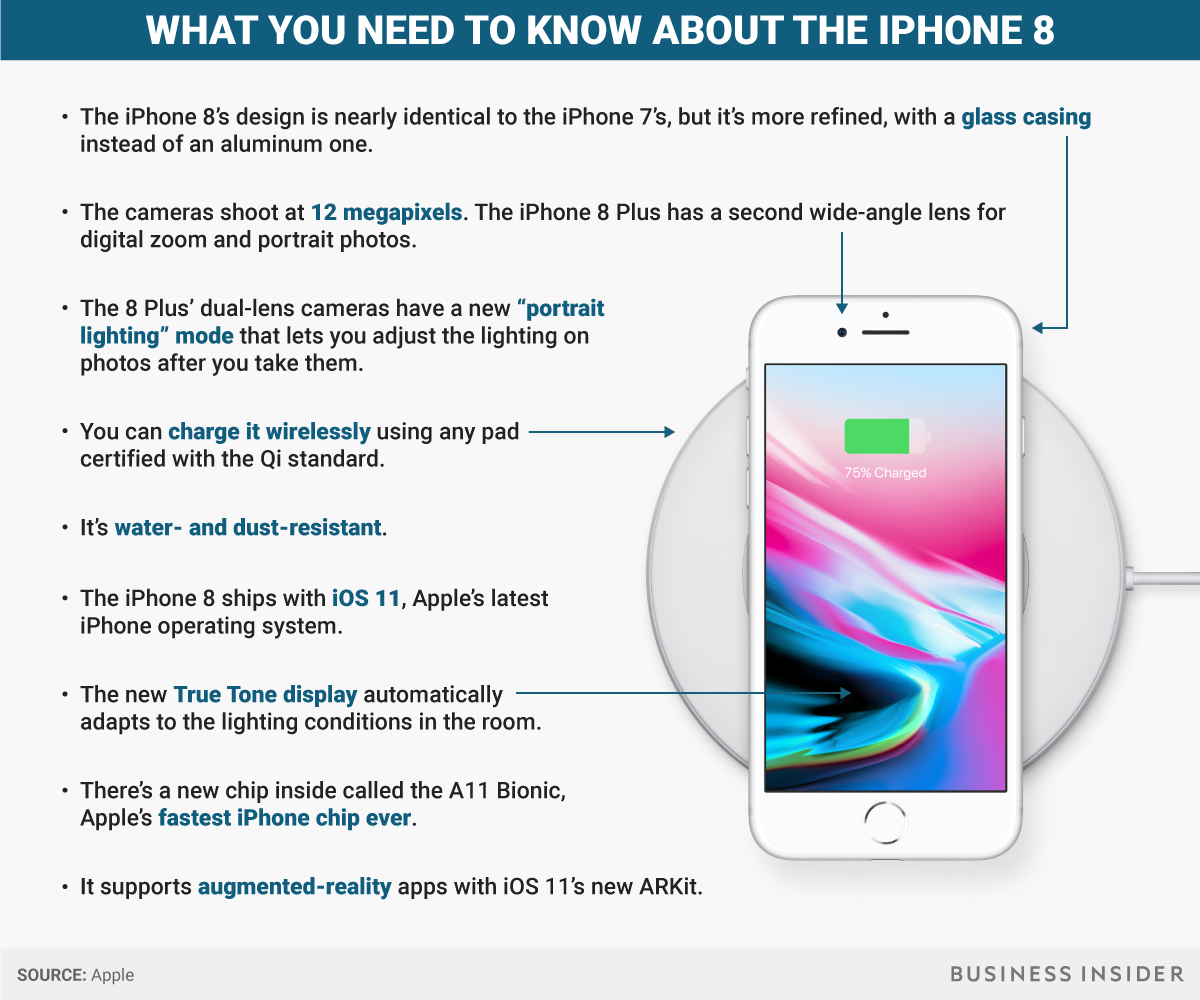Steve Kovach September 19, 2017 at 04:00AM

For the first time in the ten-year history of the iPhone, I can't recommend buying the newest models.
That's not because the new iPhone 8 and iPhone 8 Plus are bad phones. They're actually great.
But there's an even better phone on the way.
I've been using the iPhone 8 and iPhone 8 Plus for the last several days, and I think they are perfectly tuned and refined versions of last year's iPhone 7 models. They include cool new features such as wireless charging, amazing cameras, and Apple's fastest processor ever.
The iPhone 8 and 8 Plus will be the best phones on the market when they go on sale September 22. And they'll likely remain the best phones available until November, when the iPhone X arrives.
So, you have a tough decision to make if you're ready for a new iPhone this year. Do you go with the iPhone 8 (which starts at $699) or iPhone 8 Plus (starting at $799) now, or hold out another month for the iPhone X (which starts at $999)?
My call: If you choose one of the iPhone 8 models, I think you'll be happy with your decision. But I think the iPhone X's better. After spending a short time with the X last week, I think it'll be worth the wait — and its sky-high price.
Refined design
At first glance, the iPhone 8 models look nearly identical to their iPhone 7 counterparts and even to the iPhone 6s and 6 models before them. The new phones have the same 4.7-inch and 5.5 inches screens, respectively, as the iPhone 7 and iPhone 7 Plus and almost the same overall dimensions.
But Apple has updated the design of the new phones in subtle and important ways. One that struck me: the iPhone 8 models feel different than the iPhone 7 ones, because their backs are made of a new kind of durable glass. The new phones feel great. They aren't as slippery as their predecessors, whose backs were made of scratch-prone aluminum. And unlike last year's models, the iPhone 8 devices don't have any unsightly antenna strips mucking up their backs.
 The iPhone 8 models are also noticeably heavier than their predecessors, but I like that too. The extra heft makes them feel more robust and better constructed.
The iPhone 8 models are also noticeably heavier than their predecessors, but I like that too. The extra heft makes them feel more robust and better constructed.
The only downside to the design of the new phones is that it's starting to feel stale. Apple seems to have ceased its practice of giving the iPhone a thorough redesign every other year. After debuting this same basic look in 2014, the company has now used it on four sets of models in a row.
Going wireless
In addition to making the devices feel better in the hand, the iPhone 8 and 8 Plus' new glass backs come with another benefit: wireless charging. Long overdue on the iPhone, wireless charging has been available on other phones for years, and companies like Samsung have made it a key feature in their best devices. Apple hasn't been able to add it until now because the iPhone's metal construction didn't let wireless power pass through.
The iPhone 8 models will work with any charging pad that's compatible with the Qi (pronounced: chee) standard. Apple is selling Qi chargers from Mophie and Belkin in its stores, but you can find loads of others elsewhere from companies including Samsung, Powermat and Ravpower.
Apple also has a wireless charging pad of its own called AirPower in the works that will be able to charge your iPhone, Apple Watch, and Airpods at the same time. But it's not coming out until next year. Wireless charging on the iPhone 8 devices is pretty straightforward — you just plug in the charging pad and set your phone on top of it.
Wireless charging on the iPhone 8 devices is pretty straightforward — you just plug in the charging pad and set your phone on top of it.
The feature is a great addition to the iPhone line. It offers an easy way to top up your battery at the office or reduce the clutter of wires on your nightstand.
Wireless chargers are popping up in cars, restaurants, and even end tables, and I have a feeling you'll soon see it in many more places. The expected popularity of the new iPhones is going to mean lots of people will have phones that support the feature.
Power
Many of the other advancements in the iPhone 8 devices are hidden inside.
Perhaps most notable is Apple's new iPhone processor, called the A11 Bionic. That's a goofy name, but the chip's power is no joke.
To test the new chip, I used an app called Geekbench that measures and compares the processor performance of particular devices. Without getting too technical, the iPhone 8 models blew away everything else in Apple's lineup.

The iPhone 8 models make good use of that power, tapping into it to manage their camera software, improve their battery life, and make augmented reality apps pop.
And while there are other reasons to get the iPhone X, its processor isn't one of them. It will use the same A11 Bionic chip as the iPhone 8 devices.

The cameras — particularly the dual-lens camera system on the 8 Plus — represent the other big hardware advance in the iPhone 8 models. Apple has improved and fine-tuned the 12-megapixel sensors in the devices to prepare them for the upcoming onslaught of augmented-reality apps.
To my untrained eye, pictures taken with the new cameras weren't noticeably better than those made with the iPhone 7 models. However, Apple says the cameras in the new phones are more accurate at capturing colors and offer a variety of other enhancements that will improve your photos.
For the 8 Plus, Apple has added a new feature to Portrait mode, the camera setting the company introduced last year that allows you to zoom in on a subject and blur out the background behind it. Called Portrait Lighting, the new feature lets you take stylized portraits with different lighting effects, such as blacking out the entire background behind a subject.
In my tests, Portrait Lighting didn't work reliably. The lighting conditions had to be just right or the background effects could bleed onto the subject. However, Apple says the feature is still in test form and that Portrait Lighting will improve with future software updates. In the meantime, if a Portait Lighting photo doesn't turn out the way you want, you can tweak the image after the fact.
The screens on the iPhone 8 devices have some new tricks too. While they're not as stunning as the iPhone X's new Super Retina Display, they do a better job of displaying colors than the screens on last year's models.
The new screens incorporate the same True Tone display technology that Apple previous used in the iPad. That technology automatically adjusts the colors they screen display to compensate for ambient lighting conditions. True Tone is especially good indoors or in darker settings.
iOS 11 and augmented reality
 As good as each year's iPhones usually are, iOS — the operating system underlying the devices — always seems to be the most important thing in helping them stand apart from the competition. The iPhone 8 models will ship with iOS 11, the latest version, which will also be available for older iPhones and iPads on Tuesday.
As good as each year's iPhones usually are, iOS — the operating system underlying the devices — always seems to be the most important thing in helping them stand apart from the competition. The iPhone 8 models will ship with iOS 11, the latest version, which will also be available for older iPhones and iPads on Tuesday.
You'll see the most marked changed in iOS 11 on the iPad. But it still offers some nice features for iPhones. For example, you'll now be able to customize the iPhone's control panel of settings. You'll also be able to create video loops from Live Photos.
But the highlight feature of iOS 11 is ARKit, a set of software tools that allow developers to make augmented reality apps for iPhones and iPads. There are loads of AR apps that will be ready when iOS 11 launches, and more will trickle out in coming weeks.
Many in the tech world think AR is how we will interact with computers in the future. Apple is about to pull off an incredible feat with iOS 11; with its release, iOS will become the largest AR platform in the world overnight.
 AR will need a killer app to catch on. There are some cool ideas out there, including a game that can turn your coffee table into a game board, or an app that will overlay constellations on the real sky.
AR will need a killer app to catch on. There are some cool ideas out there, including a game that can turn your coffee table into a game board, or an app that will overlay constellations on the real sky.
But many of these early ideas feel gimmicky or like they will only have niche appeal. This is going to make me sound old and boring, but the best use I've of AR so far is in the new Ikea app. It allows you to place virtual versions of Ikea furniture in your home to see how they fit before you buy them.
I'm guessing developers will be doing a lot of experimentation with AR in the near future to figure out what works.
8 or X?
 Apple has never offered an iPhone lineup as broad as the one it's about to have. You can get an iPhone SE for as little as $349, or, come November, go all the way to the max with the $999 iPhone X. You almost can't make a bad choice; they're all really, really good phones.
Apple has never offered an iPhone lineup as broad as the one it's about to have. You can get an iPhone SE for as little as $349, or, come November, go all the way to the max with the $999 iPhone X. You almost can't make a bad choice; they're all really, really good phones.
The iPhone 8 models are at the more expensive end of the range. But even though they're fantastic devices, they're not as enticing as the iPhone X.
My advice is to ask yourself how much you're willing to pay. If you don't mind giving up some of the futuristic features in the iPhone X, then the iPhone 8 models will give you the same power and performance and most of the same features of iOS 11 for hundreds of dollars less.
But if the price tag doesn't scare you away, hold off on the iPhone 8s and go for the X.
SEE ALSO: The technology that wants to replace your smartphone will be everywhere in a few weeks
Join the conversation about this story »
NOW WATCH: Watch Apple's Face ID unlocking fail during its big demo
REVIEW: The iPhone 8 is incredible, but you should wait for the iPhone X instead (AAPL) from Business Insider: Steve Kovach







 The
The  I've always advised people to buy the best phone they can within their budget. If $999 works for you, then wait for the iPhone X. I spent a few minutes with the X last week, and can already tell
I've always advised people to buy the best phone they can within their budget. If $999 works for you, then wait for the iPhone X. I spent a few minutes with the X last week, and can already tell 
 The iPhone 8 models are also noticeably heavier than their predecessors, but I like that too. The extra heft makes them feel more robust and better constructed.
The iPhone 8 models are also noticeably heavier than their predecessors, but I like that too. The extra heft makes them feel more robust and better constructed. Wireless charging on the iPhone 8 devices is pretty straightforward — you just plug in the charging pad and set your phone on top of it.
Wireless charging on the iPhone 8 devices is pretty straightforward — you just plug in the charging pad and set your phone on top of it.
 As good as each year's iPhones usually are, iOS — the operating system underlying the devices — always seems to be the most important thing in helping them stand apart from the competition. The iPhone 8 models will ship with iOS 11, the latest version, which will also be available for older iPhones and iPads on Tuesday.
As good as each year's iPhones usually are, iOS — the operating system underlying the devices — always seems to be the most important thing in helping them stand apart from the competition. The iPhone 8 models will ship with iOS 11, the latest version, which will also be available for older iPhones and iPads on Tuesday.